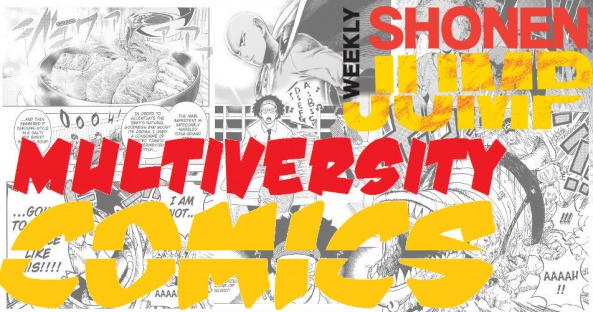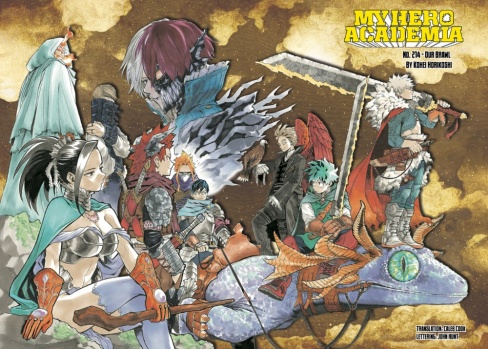
Welcome to This Week in Shonen Jump, our weekly check in on Viz’s various Shonen Jump series. Viz has recently changed their release format, but our format will mostly remain the same. We will still review the newest chapters of two titles a week, now with even more options at our disposal. The big change for our readers is that, even without a Shonen Jump subscription, you can read these most recent chapters for free at Viz.com or using their app.
This week, Rowan and Matt check in on “Black Clover” and “My Hero Academia.” If you have thoughts on these, or any other current Shonen Jump titles, please let us know in the comments!

Black Clover Chapter 190
Written and Illustrated by Yuki Tabata
Reviewed by Rowan Grover
Tabata’s “Black Clover” continues the journey to 200 chapters with the latest chapter, “Go!!!!”. The team gets to celebrate a moment of brevity, and it is quite refreshing to see the team, even if only for a few pages, get to revel in their break. Tabata understands that about long-form stories and classic Shonen stories in general and brings slapstick humor and camaraderie to the big two-page sequence at the start. However, the story is interrupted by two big names, Captains Fuegoleon and Mereoleona. Tabata provides a suitable build up for these two characters, with a few pages worth of rumbling and people crying out. There’s a big payoff three-quarter splash page as Tabata renders Fuegoleon with his Salamander, which is dramatically staged, and appropriately has even the main cast standing back in awe. Like a good Shonen series, Tabata knows when to pull back and celebrate, and when and how to show off a powerful force.
There are a few nice character moments in this issue too, especially for Asta, even as he takes a backseat to the action. He’s portrayed as incredibly innocent in the first scene, as he reveals that he promised the woman from the Eye of the Midnight Sun that she ‘could do anything with his body’. He gets a few neat fanboy moments as the two captains arrive later, working well as a commentator for the readers of these characters. However, a lot of this issue is characterized by everyone yelling constantly at each other, and this can be a good thing sometimes, and a little draining for the rest of the issue. It’s poignant when Solid bids farewell to his sister Noelle, yelling passionately that he will match her in strength someday. It’s a little much when around 90% of the rest of the speech bubbles are punctuated with multiple exclamation marks. For a medium that lacks audio, this is a very loud comic and can lead to unnecessarily fast pacing as readers scroll quickly through this type of punctuation.
Despite what might detract from this series narratively, Tabata’s art remains some of the most unique of the long-running Shonen series. We’ve got a lot of action intermingling with the environment in this issue, which Tabata masterfully choreographs with dynamic camera angles and paneling. As soon as we hear an “Incoming from the capital!” about a quarter of the way through the chapter, we start to see visual cues of an oncoming threat, and Tabata stages this from a diagonal camera angle that feels action oriented. The next panel shows quick impact as the distant lights now coming ripping through the earth itself, debris and land spiraling behind them. When the elves arrive a little later, we see them smash down the wall of the castle with brutal impact, before standing menacingly in its broken wake the next panel, Tabata cleverly stages the edges of the wall around the posing Elves. It’s a lot of fun and leads to some kinetic action sequences.
Tabata seems to have a thing for characters that overly exclaim themselves in action and dialogue sequences. It makes for a light-hearted series, as a lot of the characters, Asta especially, look like they are constantly having the time of their lives. Going from exaggerated excitement in the first sequence to sheer awe when the captains show up, Asta is a wealth of positivity in any situation. Having the exchange between the two captains is a lot of fun too, as Fuegoleon is the highly serious and judgemental yin, with Mereoleona being the leering, creepy and confident yang. The high octane excitement wears a little thin, however, especially later in the chapter. We get a sequence of the Black Bulls with their mouths open in exclamation, followed by Asta doing the same thing, and Mimosa repeating this but with a slightly tilted mouth. It makes me question Tabata’s ability for emotional language despite the other good stuff in this chapter.
Continued belowBlack Clover continues to truck along, delivering quiet moments while establishing big players in the same chapter. The high-excitement tone of the series can be a little grating at times but still manages to be enjoyable at the end of the chapter.
Final Score: 7.0 – A fun “Black Clover” chapter opening with a quiet scene and ending with a bang.

My Hero Academia Chapter 214
Written & Illustrated by Kohei Horikoshi
Translated by Caleb Cook
Lettered by John Hunt
Reviewed by Matt Lune
The fight continues between class 1A and 1B, and while previous chapters of this battle tend to all blend into one at this point, this chapter feels like a complete change of tone. Whether it’s the dynamic between Midoriya and Shinso, Aizawa showing his affection for the two rivals, Mineta and Ashido stepping up their game, or Monoma’s fascinating new character developments, there’s a lot going on here. It almost feels as though there’s not as much going on within the panels themselves as there is around them if that makes sense. Characters are developing in ways that may not seem especially explicit on the page, but for longtime fans of these characters, there are some very notable moments.
The chapter begins by continuing and expanding the conversation between Aizawa, Vlad, and All Might, the former explaining to his colleagues why he’s happy to let the fight between Midoriya and Shinso continue. It seems a little hypocritical of Aizawa at first given that he’s stopped fights like this before, but his motivations are clear: he loves the passion of these two combatants. Their hearts are still in it, which is why he’s letting them carry on, despite Midoriya seemingly willing to fight Shinso quirkless if necessary. Let’s face it: Aizawa has a major soft spot for Shinso too, and to his credit, it’s great to see Shinso show a lot more tactical restraint over his scarf. This isn’t the same character that faced off against Midoriya at the Sports Festival. There’s a montage, later on, showing Aizawa teaching that restraint to Shinso, so it’s good to see him develop his skills in this way.
It’s to Midoriya’s credit too that he chooses initially to fight quirkless. His powers are unstable at the moment, so he risks a lot by engaging them. Despite this, the cliffhanger of the chapter sees him pull off Black Whip without any apparent consequences. We’ll have to wait until next week to see how successful he is. While their rivalry is fascinating, what’s great about this chapter is its devotion to other characters, like Ashido and Mineta, who significantly improve their quirks here. Ashido can actually launch acid blasts over a greater distance now, and Mineta’s bouncing ball skills are used in really unique ways. Sure, he’s still a sleazeball, “accidentally” colliding with Ashido’s chest, but his offensive techniques have come on leaps and bounds (pun absolutely intended).
The most fascinating aspect of this chapter, however, is Monoma. Looking online, there are a couple of different interpretations of the translation here, but essentially it seems as though Monoma is gearing up for something of a heel turn. He talks about how he’s coming to accept that he’ll never be the main hero and that sometimes it’s even ok to be the guy that opposes the main hero. While this could just be an extension of the dynamic already established with him and Shinso, in the sense that they’re both characters who have come to terms with the fact that their powers can have pretty morally negative side effects, this could be the beginning of a fascinating contrast between the two. Shinso has been able to use the negative aspects of his powers in a way that positively impacts his heroic career, whereas Monoma, presented with the same problem, is seemingly going down a darker path. He’s definitely one to watch moving forward.
Final Verdict: 8.0 – Solid character development takes center stage, and this chapter is all the better for it.






